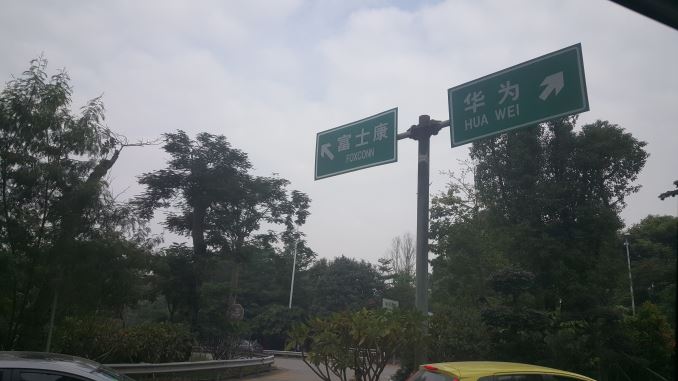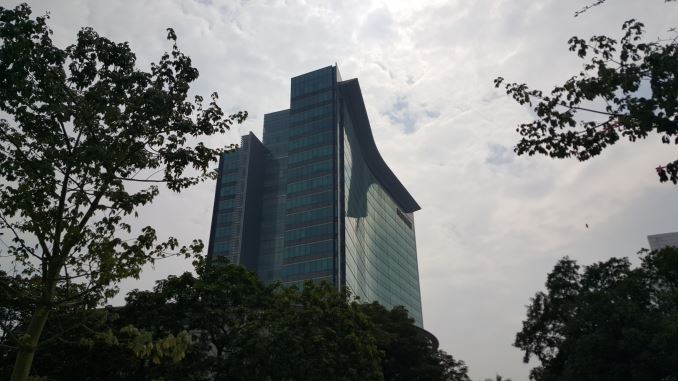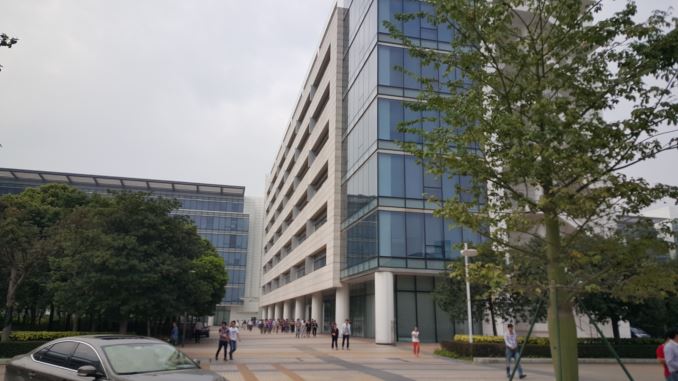China Calling: Huawei’s Media Tour, Kirin 950 and Why We Went
by Ian Cutress on December 4, 2015 8:00 AM ESTIt’s Just Another Smartphone Factory™
In a very typical stereotype, the campus in Shenzhen for Huawei has around 30,000 employees over 2.5 square kilometers, with some of them located in housing nearby within the local area. Perhaps quite interesting is that there are Foxconn offices across road, to the extent that at one T-junction there was a sign for left saying ‘Foxconn’ and a sign for the right saying ‘Huawei’. It has been noted that Foxconn has manufactured products for Huawei before, and thus I can imagine being so close to each other has its own benefits.
Make sure you make the right turn
Needless to say, a campus this size is very difficult to ‘tour’ around, especially as we had special presentations and meetings with the President of Huawei’s watch division discussing the Huawei Watch, lunch with the Director of Global Relations as well as a tour of the testing facilities during the short time there.
The standard rules apply for a company of this nature – there are tall corporate buildings with product areas and descriptive walkthroughs of what the company does, with professional meeting rooms that have in-house catering, whereas the technical offices and data center management are generic looking concrete places that are mostly no-go areas for media visits. This dichotomy between ‘on-show corporate’ and ‘the general workforce’ is mirrored in companies around the world, to the extent that we also had lunch in a special canteen for guests with a background band as you entered.
Musical accompaniment in the executive dining hall reception
During lunch we ate and talked with the Director for Public Relations, rather than eating in the casual employee canteen and experiencing the potential mêlée that comes with that. However, the campus is designed with an element of beauty in mind, under the premise that the CEO has a degree in architecture, and wanted the campus to reflect an element of style rather than be another box hidden in a corporate mountain. It was at this point that it was suggested by Andrei that the ultimate tech press clickbait article would be ‘An In-Depth Look at Huawei’s Architecture’ and it being about the buildings and landscapes of the campus, rather than insights into the company's silicon or devices.
Part of the tour was also to one of the smartphone testing laboratories, although we were not allowed to take images inside of the facilities. If any of our readers have seen our articles in the past about this (such as ASUS), the usual array of drop tests, twisting tests, insertion, vibration, high temperature, low temperature, humidity cycles and battery presses were also present on site, although RF testing is performed on a different campus than the one we visited. So when this page started with ‘It’s Just Another Smartphone Factory’, the reality is that almost all of them are like this, as they all need to perform similar tests dictated international and industry standards. The key here is individualization - most of the key elements to what a company does with their product is in the hardware design stage or software, rather than product testing, unless water/dust resistance is a key factor, or additional MIL-SPEC (military standard) is needed. Even then, for MIL-SPEC, one would assume that the testing would be outsourced if it only applied to a few devices, rather than purchasing all the equipment.














109 Comments
View All Comments
Ryan Smith - Saturday, December 5, 2015 - link
"Earnest question to editors: Would you have gone if the trip wasn't free?"No, honestly not. And that's not because we don't like covering Huawei - they're a big part of what's going on in the world of smartphones - but there is a major opportunity cost to a trip like that. One trip like that would cost as much as covering several companies in the US/EU for us. We do have to be mindful of our costs - I don't need to point out that many of our readers know how to use ad blockers - so foreign trips are not something we frequently get to make.
But conversely that doesn't mean Huawei isn't worth covering. Only that it's in their own self-interest to invite us out if they want to make sure we have a chance to see their facilities. After all, we could always decline it if we weren't already interested.
s.yu - Sunday, December 6, 2015 - link
lol, on Edge, 100% ad pass-through.ummduh - Sunday, December 6, 2015 - link
re: adblockThis reminded me to turn on AdBlock's "allow some advertising" option, and then I went ahead and whitelisted Anadtech too, since I do quite enjoy reading and using this site. Reloaded Anandtech, and WHAM! Big ol pop up right in the middle of the screen that you have to click away to be able to continue. THIS is why we have AdBlockers. Whitelisting has been revoked.
masimilianzo - Sunday, December 6, 2015 - link
Is Andrei the one on the right of Ian? Or on the left?Ryan Smith - Monday, December 7, 2015 - link
Left.s.yu - Sunday, December 6, 2015 - link
There seems to be some serious latency problems with the comment system, or are comments under this post heavily moderated because of heated discussion?Ryan Smith - Monday, December 7, 2015 - link
We do engage in very occasional moderation, but there's no "latency" in comment publication. Anything posted should be immediate.s.yu - Tuesday, December 8, 2015 - link
It really wasn't. The correction about the incorrect speculation on pronunciation I posted earlier, I posted it, went on to post some other reply, then flipped through the pages again and noticed that it was gone. So I reposted it and left a copy in the clipboard, hit refresh, came back to check, and it was gone again. So I pasted the copy directly, then refreshed, and it was gone again, tried again, and got the same results. The last time I tried I added another sentence, but again it disappeared after a refresh, but I wasn't so persistent to try a fifth time, so I left it that way. After a day, I came back, I found all four posts there. I don't know where the glitch might have been.BTW, the pronunciation is pretty easy, even in English, because it's not difficult to find English words as reference, so this helps in identifying the phonemes. I don't know what the problem was.
So first, treat "Hua" as a full syllable, but treat "Hu" and "a" as half a syllable each. The "Hu" is highly similar to "who", in English, and it's probably the most accurate direct representation, so just pronounce the "Hu" as "who", only shorter, as its treated as half a syllable. As for the "a", it's nonexistent in American English, but exists in British English, like the stiff-tongued version of the "ar" in "hard". Again, shrink that stiff-tongued "ar" to half a syllable and pronounce it in a single syllable along with the "Hu", and you're past the "Hua".
As for the "wei", really simple. It's basically a "way". There's no perceivable difference between the two, except for the tone. In regions around Beijing, the accent might turn the "w" into a "v", so you get a "vey", or the "vai" in "vain", but in standard Mandarin it's still "w".
If you're even meticulous about the tone, then try pronouncing the two syllables like a question each, like "Hua?Wei?" And the tone would sound like the correct Chinese pronunciation too, but this is practically useless beyond actually communicating in Chinese.
s.yu - Tuesday, December 8, 2015 - link
Oh, regarding the "who", the "English who" is again more accurate than the "American who", so try making a little more room in your mouth and don't let your tongue obstruct the air flow.zodiacfml - Sunday, December 6, 2015 - link
Wow, I did not learn anything nor found intriguing! Yet, there's something respectable about them with their approach which is almost like Apple, where they can sell their devices for a higher price than their competitors.